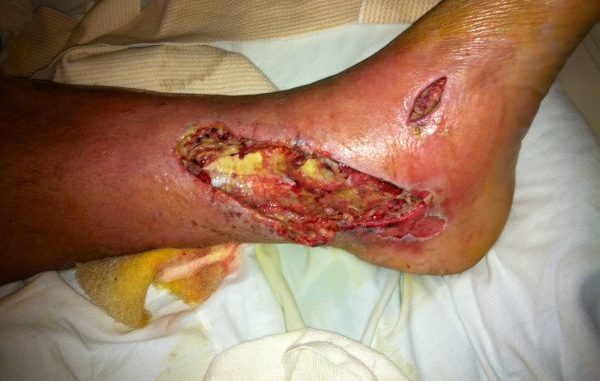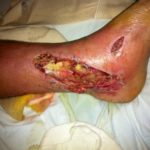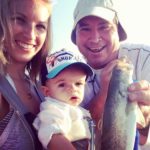
Grand Isle trip ends in two-week hospital stay, ongoing wound care
As Rick Garey fished along the rocks in front of Grand Isle on June 7, he caught a lot more than the seven speckled trout he reeled in late that afternoon.
He also contracted vibrio vulnificus, a potentially deadly bacteria that thrives in warm salt water.
In an ill-fated attempt to climb the rocks and fish the other side, Garey slipped, gashed his shin and scraped his left ankle on some barnacles. He didn’t know it then, but those minor ankle scrapes were the entry point for the bacteria.
Within 48 hours, the 56-year-old from Gonzales would literally be fighting for his life.
A two-week hospital stay (including three days in critical care), seven surgeries, multiple visits to a hyperbaric chamber in Baton Rouge and ongoing wound care were about to become a part of his life story.
“He thought he had just sprained his ankle, so he came back to the camp, cleaned it up and washed down his shin, which had a huge gash on it,” according to his wife, Kathleen. “Then he went back out fishing.”
The next day, Garey said he still felt pretty good, even though his ankle was bothering him a bit more.
“I wasn\t quite up to par and I decided not to go out in the boat, but I was still thinking that I had sprained my ankle,” he said. “It was starting to turn a little purple, just like it would if I had twisted it.”
As the owner of Ascension Soccer Academy, Garey is quite familiar with twists and sprains, and wasn’t aware that the bacteria were already at work destroying the flesh near his left ankle.
After a sleepless night, Rick and Kathleen went to the emergency room in Cut Off at Lady of the Sea General Hospital on Sunday morning. Still under the impression that his discomfort was being caused by an ankle sprain, the staff X-rayed his foot and saw an old break in one of his bones.
They prescribed some painkillers and antibiotics to prevent the gash on his shin from getting infected, and suggested that he go to see an orthopedist about his ankle when he returned home to Gonzales.
So the couple returned to Grand Isle, where they had rented a beach house with their children, in-laws and grandkids. But his condition continued to deteriorate throughout the day.
“By Sunday evening, things were going south pretty fast,\” he said. \“I got up after a nap and, literally, my T-shirt was stuck to me, like somebody was running a shower over me. I got hot, my stomach was ripping, my leg was throbbing.
“I was thinking, ‘What’s going on here? Something is really wrong, and it\’s not a twisted ankle.’”
Kathleen said the family thought he might be having a heart attack.
“He turned white as a ghost and his chest was hurting him,” she said. “So we called 911 and they took him back to the hospital, where they lost his blood pressure.
“He was in septic shock.”
Rick remained conscious throughout the ambulance ride from Grand Isle back to Cut Off.
“I was heading down the tubes really fast at that point,” he said. “They got me on the table at Lady of the Sea and couldn\’t get a blood pressure or a pulse. I felt like I had about two heartbeats left.”
Garey said they gave him a shot that stimulated his heart and stabilized him before he was transported by ambulance to Terrebonne General Medical Center in Houma.
That’s where Dr. Mary Eschete, an infectious disease specialist in Terrebonne Parish, saw him late that evening.
“Vibrio is a living bacteria associated with brackish and salt water,” Eschete said. “It is rapidly progressive. You have a minor injury to the skin, and then a few hours later it starts turning this violaceous (bright red) color and rapidly progresses from there.
“Within 12 hours, the person will usually have a very low blood pressure.”
Garey said Eschete was instrumental in the medical team\’s success in saving his foot — and ultimately his life. Despite the lab culture initially coming back negative, possibly because of the antibiotics he took earlier on Sunday, the doctor was confident vibrio was the culprit.
“She was the one who said, ‘I know what it is. It smells like it. It looks like it. It acts like it. That’s what it is,’ ” Garey said. “And she started the regimen to attack it. That was a huge role in me making it through.”
Eschete said many of the region’s healthcare professionals recognize vibrio when they see it. But the key is to seek help in time.
“Most of the doctors in this area are used to seeing it and know pretty rapidly that it requires antibiotics and surgical debridement (removal of dead tissue) immediately,” Eschete said. “When visitors come down here from other places and go back home where they might not know about it, then they can get into trouble.”
Although anyone can contract vibrio, Eschete said people with diabetes, cancer, liver disease, transplant patients and those who are immune-suppressed for any reason are at a higher risk.
These groups, she said, should not swim in salt water or handle any type of raw seafood taken from salt water, like shrimp, oysters or fish. The bacteria can also be ingested through contaminated seafood, she said.
The number of patients she sees with vibrio infections varies from year to year.
“It goes in spells,” Eschete said. “This organism likes warm water, so we don’t usually see it in the cooler months. We usually see it a little earlier than this, but we had a cool spring.
“Now it’s hotter, and we’re starting to see it again.”
Click here to learn how to help prevent a vibrio infection.
Rick Garey still has a long road to recovery ahead, but is thankful that he survived. And as a soccer trainer, he is especially grateful the surgeons in Houma were able to save his left foot.
“The bacteria didn’t get past the covering on top of the muscle tissue in my foot,” he said. “That left all of the tendon and ligament and bone structure whole. By not getting into that, they didn’t have to amputate.”
Eventually, once his wound finishes healing, Garey said he plans to resume fishing. He’ll be more careful, and he hopes his ordeal will be a wake-up call for everyone concerning vibrio, especially how fast it progresses.
“Just be diligent. Take precautions. Keep hand sanitizer on your boat,” he said. “Check the kids when you get back to the camp. Use gloves or a fish handler to put fish in the ice chest. When you\’re done with your catch, wash up. When you’re cleaning fish, wear gloves.
“It’s simple things. Just do whatever you can to prevent this catastrophe from happening to you.”
Garey stressed the importance of not waiting to get help if you think you may be infected, and recalled what a doctor in Houma told him during his two-week stay there.
“He said, ‘The reason you\’re alive is because you didn’t play macho man. You realized something was wrong and you immediately came in to try to get help,’” Garey said. \“That, in the end, is what gave them a chance to save me. Nothing can prepare you for this. This will knock the biggest person down in a heartbeat. It ate a golf ball-sized hole in my ankle.
“You won’t beat it on your own. So get help and get it quick, because it’s a race against time. The sooner the experts can draw blood and take cultures, the faster they can save your life.”




